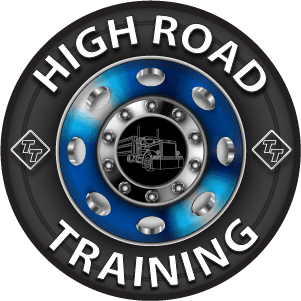CDL Practice Tests: Dominate The CDL Exam!
Choose A Section:
Go!When stopping a school bus at a bus stop, what two things must you do?
- Release the parking brake and activate the warning buzzer
- All these are correct
- Swing the nose of the bus toward traffic a few feet and reach your arm out the window to signal your intentions to traffic
- Put the transmission in "park" or "neutral" and set the parking brake
When stopping, you should:
- Bring the school bus to a full stop with the front bumper at least 10 feet away from students at the designated stop. This forces the students to walk to the bus so you have a better view of their movements.
- Place transmission in “Park” (if there is no “Park” shift point, place in “Neutral” and set the parking brake at each stop.
- Activate alternating red lights when traffic is a safe distance from the school bus and ensure stop arm is extended.
- Make a final check to see that all traffic has stopped before completely opening the door and signaling students to approach.
Which of the following is NOT true about personal conveyance in a commercial motor vehicle?
- A driver may record time operating a CMV for personal conveyance as off-duty only when the driver is relieved from work and all responsibility for performing work by the motor carrier
- Motor carriers can not make personal conveyance limitations that are more restrictive than the guidance provided by the FMCSA
- The CMV may be used for personal conveyance even if it is laden (loaded)
- Personal conveyance does not reduce a driver’s or motor carrier’s responsibility to operate a CMV safely
In addition to checking the lighting indicators listed in Section 10.2 of this manual, school bus drivers must also check which of the following lighting indicators:
- Alternately flashing red lights indicator.
- Alternately flashing amber lights indicator, if equipped.
- All these are correct
- Strobe light indicator, if equipped.
In addition to checking the lighting indicators listed in Section 10.2 of this manual, school bus drivers must also check the following lighting indicators (internal panel lights):
- Alternately flashing amber lights indicator, if equipped.
- Alternately flashing red lights indicator.
- Strobe light indicator, if equipped.
If the coolant recovery container is not part of the pressurized system:
- Never try to add coolant to any cooling system when the engine is hot, regardless of the type of coolant recovery container
- The operating temperature in this type of system will be higher than in most
- The radiator cap is more prone to leakage in this type of system, so check it often
- The cap can be safely removed and coolant added even when the engine is at operating temperature
Some vehicles have sight glasses, see-through coolant overflow containers or coolant recovery containers. These permit you to check the coolant level while the engine is hot. If the container is not part of the pressurized system, the cap can be safely removed and coolant added even when the engine is at operating temperature.
During the CDL exam, when a driver stops and reverses direction to get a better position, it is scored as a:
- Reversal
- Pull-up
- Crossover
- Insurgent
Which of the following describes a dual air brake system?
- The first system is called the “primary” system. The other is called the “secondary” system.
- All these are correct
- One system typically operates the regular brakes on the rear axle or axles. The other system operates the regular brakes on the front axle (and possibly one rear axle). Both systems supply air to the trailer (if there is one).
- A dual air brake system has two separate air brake systems, which use a single set of brake controls. Each system has its own air tanks, hoses, lines, etc
When students are loading the bus at the school campus you should:
- Turn off the ignition switch
- All these are correct
- Position yourself to supervise loading as required or recommended by your state or local regulations
- Remove key if leaving driver’s compartment
The loading procedure is essentially the same wherever you load students, but there are slight differences. When students are loading at the school campus, you should:
- Turn off the ignition switch.
- Remove key if leaving driver’s compartment.
- Position yourself to supervise loading as required or recommended by your state or local regulations.
Which of the following is NOT true about the 16-hour lobgook exception?
- Allows drivers who have started and stopped their workdays at the same location for the previous five work days to extend their 14 hour clock to 16 hours one per week
- The driver can remain on-duty for an extra 2 hours but must be relieved from duty immediately after the 16th hour
- This exception does not extend the allowed 11 hours per day of driving
- This exception allows the driver to extend their 14-hour and 11-hour clocks by two hours once per week
To summarize the 16-hour exception:
- Allows drivers who have started and stopped their workdays at the same location for the previous five work days to extend their 14 hour clock to 16 hours one per week
- The driver can remain on-duty for an extra 2 hours but must be relieved from duty immediately after the 16th hour
- This exception does not extend the allowed 11 hours per day of driving
Using the following numbers, what would be the final result if you moved the 5th wheel forward two holes?
drive axles: 34,100 pounds
Weight transfer: 500 pounds per hole
- steer axle: 10,300 pounds
drive axles: 34,600 pounds - steer axle: 9,800 pounds
drive axles: 35,100 pounds - steer axle: 11,800 pounds
drive axles: 33,100 pounds - steer axle: 11,300 pounds
drive axles: 33,600 pounds
2 holes x 500 pounds per hole = 1000 pounds of weight transfer from the drive axles to the steer axle.
10,800 + 1000 = 11,800 pounds on the steer axle after transfer
34,100 - 1000 = 33,100 pounds on the drive axles after transfer
Define aggressive driving:
- Taking the off-ramp without first getting into the proper gear
- Staying in the left lane below the speed limit, angering other drivers
- Driving just a few miles per hour above the speed limit to save a few minutes
- The act of operating a motor vehicle in a selfish, bold, or pushy manner, without regard for the rights or safety of others
Aggressive driving is the act of operating a motor vehicle in a selfish, bold or pushy manner, without regard for the rights or safety of others.
CDL Manual Sections To Choose From:
- Introduction
- Driving Safely
- Transporting Cargo Safely
- Transporting Passengers Safely
- Air Brakes
- Combination Vehicles
- Doubles and Triples
- Tank Vehicles
- Hazardous Materials
- School Bus
- Vehicle Inspection
- Basic Vehicle Control Skills Test
- On-Road Driving
- Logbook
- Weight And Balance
- Flatbed Cargo Securement
- New York State Coil Endorsement
CDL Practice Tests
Our CDL practice tests are designed to help test your knowledge of the CDL Manual and sharpen your skills for taking the CDL permit and endorsement exams. They are not designed to teach you the knowledge necessary to pass the exams. Please do not try to memorize CDL practice tests in order to get your CDL. There's a better way.
Our High Road CDL Training Program is by far the easiest and most effective way to learn the materials necessary for passing your written CDL exams and preparing for a great start to your career. We strongly suggest using the High Road (which is 100% free!) to learn the CDL manual before using our CDL practice questions to test your knowledge.
How to Pass CDL Permit Test the First Time
The Class A CDL permit exam consists of a multiple choice test covering 20 different areas related to commercial driving. To prepare for this test, it is important to do practice tests beforehand. Knowing your personal study habits, getting enough rest, and eating a healthy breakfast will also set you up for success.
Tips For Passing the Commercial Driver's License (CDL) Permit Test
- Practice Makes Perfect: The best way to both mentally and physically prepare for the written exam is to take practice tests. Start out with open-book tests and gradually work your way up to giving yourself a time limit. Finally, before the big day, take a practice exam as if it were the real thing without any help. This will give you a good indication of how well you understand the material.
- Understand Instead of Memorize: Memorizing information can be helpful for the written exam, but the key to being fully prepared is to understand the material rather than just memorizing it. Understanding the material will allow you to answer questions correctly no matter how they are worded.
- Real World Applications: When struggling to understand concepts, create real-world scenarios to make the information more relevant to your life. Doing this will make it easier to remember come test time.
- Utilize Study Strategies: Utilizing study strategies such as flashcards, songs, rhymes, and phrases can help you remember the material.
- Be Fresh and Alert: The night before the exam, get a good night's sleep and eat a filling breakfast on the morning of the exam. This will ensure you are fresh and alert to take your exam.
- Begin Early and Space out Your Studying: It is important to give yourself ample time before the exam to get familiar with the material and get your mind ready for the big day. Consider taking a training course online or in-person, if it's required. Shop around for a course that works best for you. By following these tips, you will be well prepared for your written CDL exam and on your way to a successful career.







 TT On Facebook
TT On Facebook